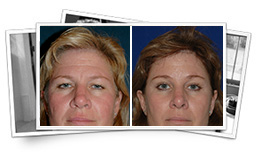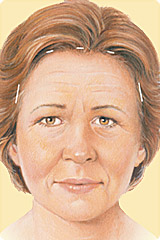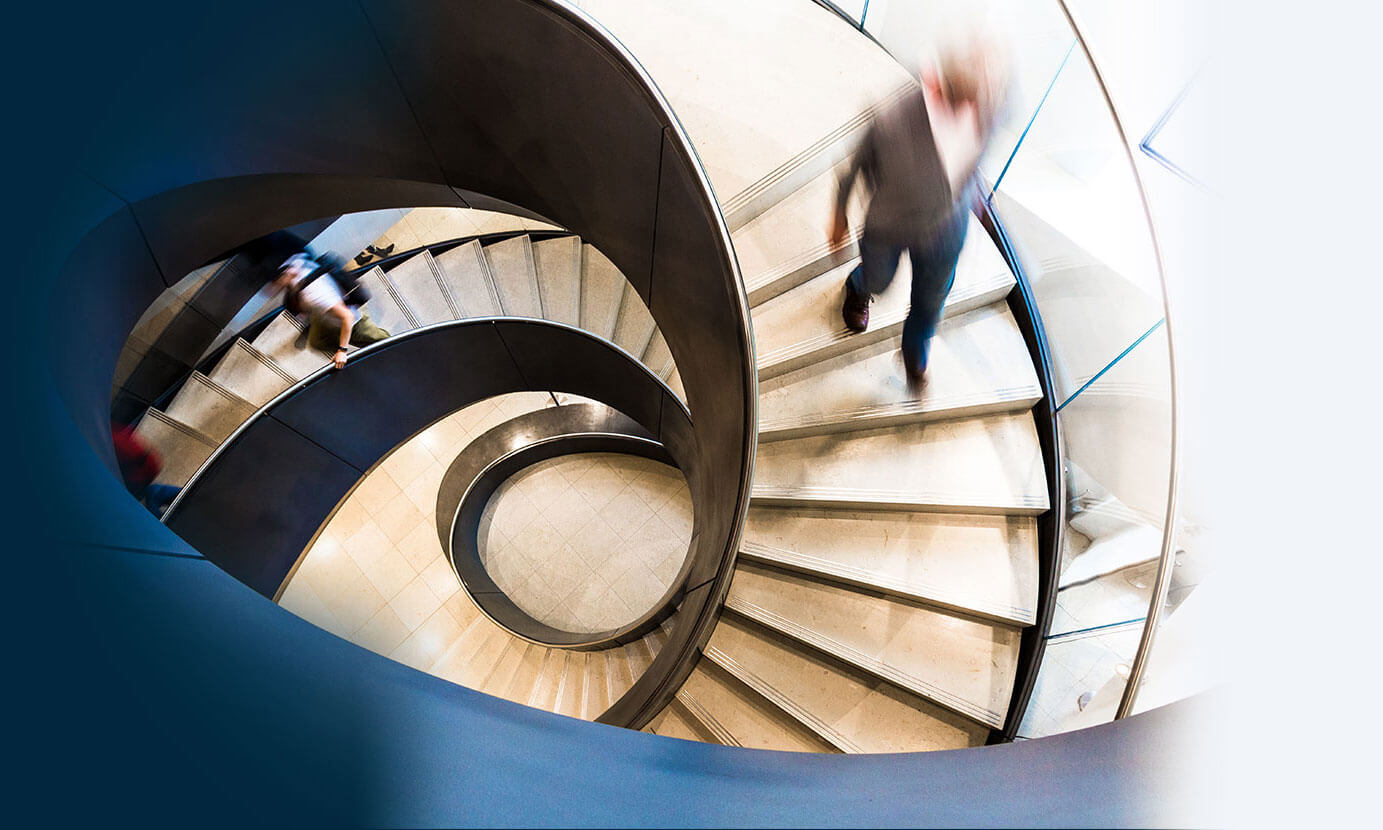Brow Lift Thousand Oaks
To rejuvenate aging brows, many patients come in for a brow lift at our Thousand Oaks plastic surgery facility. As we age, our brow descends from its normal youthful position, creating a “tired” look. This is called brow ptosis. Some brow lift procedures are meant to address the entire brow, whereas others target only the outer portion of the brow.
Before & After Photos
 Brow Lift Surgery
Brow Lift Surgery
At the Kryger Institute of Plastic Surgery, we have experience in a vast array of surgical and non-surgical procedures. Click below to see some before and after photos of brow lifts.
 Several small incisions are used. These are all hidden in the hairline.
Several small incisions are used. These are all hidden in the hairline.The traditional forehead lift involves making an incision along the entire length of the hairline. This is termed a coronal browlift. Most plastic surgeons have abandoned the coronal browlift due to the long scar and risk of hair loss (alopecia) at the scar site, and have instead turned to less invasive techniques.
The development of the endoscopic browlift (or endo-brow procedure) allows a similar lift to be performed through three small incisions hidden in the hairline. The temporal browlift raises the outer brow through two small incisions hidden in the hairline. Finally, the brow can be raised entirely through an upper eyelid incision, termed a browpexy.
The surgeons at the Kryger Institute offer all of the forehead lift techniques and will choose the procedure that is best-suited for you.
Who is a good candidate for a brow lift?
Any patient with eyebrows that have descended from their original youthful position who is otherwise in good health may be good candidates. Most browlift patients are in their 40s, 50s or 60s, however some patients in their 70s who are in excellent health may also be good candidates.
Smokers must quit for 6 weeks before and 6 weeks after the surgery. If they do not quit smoking, there are significantly increased risks associated with the surgery. People with receding or very high hairlines can still undergo a browlift, however their scars may be more visible due to a need to place the scars in skin creases of the forehead.
Are there any non-surgical alternatives to surgery?
The brow is elevated by the large flat muscle in the center of the forehead termed the frontalis muscle. This is the “good” muscle that keeps the brow high and youthful. In contrast, it is depressed downward by the “bad” muscles, namely the corragators, procerus and orbicularis oculi muscles.
In patients with minimal brow ptosis, paralyzing these muscles with Botox injections can help elevate the brow, especially the central portion of it. For the majority of patients, however, some type of surgical procedure is required to achieve a long-lasting, substantial improvement.
Preparing for surgery
Tell your surgeon about any medical problems you have, and any problems you may have had with surgery in the past. A history of bleeding problems, nausea with surgery and high blood pressure are all important to disclose to your surgeon, because these are risk factors for post-surgical bleeding.
Inform him what medications you take-both prescription and non-prescription (including herbs and dietary supplements). You will be told which medications to stop and which to take before surgery. Blood thinning medication, aspirin and anti-inflammatory medications such ibuprofen and Alleve must be stopped for 7 days before surgery.
Finally, you must strictly follow the instructions about when to start fasting before surgery (usually at midnight). If you get sick or have any health issues in the days before surgery, please notify the office at once in case we have to postpone your operation.
The surgery and the incisions
The operation itself takes 1-2 hours depending on what type of browlift you undergo. Most procedures are performed in the operating room, however some less invasive forehead lift techniques can be done in the office. The morning of surgery, your surgeon will answer any last minute questions you may have. He will mark the incisions on your face. In most cases, the incision can be hidden in the natural skin creases and within the hair of the scalp.
The anesthesia
A browlift can be performed under “twilight” anesthesia or general anesthesia. Twilight anesthesia consists of intravenous sedation and pain medication that keeps you relaxed and sleepy during the surgery. In addition, the surgeon uses local anesthesia to numb the forehead.
General anesthesia involves going completely to sleep with a breathing tube in your throat. There is a slightly higher risk of nausea and vomiting after general anesthesia, however both techniques are extremely safe. Your surgeon will discuss the anesthetic options with you before surgery.
Can other procedures be performed at the same surgery?
Yes. The surgeons at the Kryger Institute routinely perform other procedures in conjunction with a browlift. Most commonly, eyelid surgery (blepharoplasty) is performed at the same time in order to achieve a maximal restoration of your youthful appearance.
Other procedures such as a facelift, fat injections, fillers, chemical peels can also be performed at the same time. The main limiting factor in performing multiple procedures at one operation is the increased length of surgery and the risks associated with this.
What kind of dressings and drains are there?
The dressings are removed the day after surgery. This is usually done in the office. Once the dressing comes off, there is no need for any further dressing.
It is normal for a small amount of fluid to leak from the incisions for the first 24 hours. This fluid looks like “Cool-aid” or fruit-punch and is part of the normal healing process. If you have leaking fluid that persists more than 48 hours after surgery, call the office.
The incisions are usually closed with staples, and antibiotic ointment should be applied twice a day to all the incisions once the dressing comes off. Drains are not required for forehead lifts.
Can you go home the day of surgery?
A browlift can be done safely as an outpatient, and most patients will be able to go home the same day. In some cases, your surgeon may recommend that you spend a night in the hospital after surgery. Also, some patients may prefer to spend a night in the hospital if they have young children at home or live alone and do not have any help at home.
How much pain is there after surgery?
Pain from a browlift is highly variable, and ranges from minimal to mild. It is worst in the first 24 hours, but then it rapidly improves. It is impossible to predict a person’s pain level. If you have done well with surgery in the past, you will likely be fine after this surgery. Many patients have adequate pain control with Tylenol.
Our surgeons have a lot of experience treating pain, and have published scientific articles and written book chapters about anesthetics and pain control. They will do everything possible to minimize your pain, including using pain pumps after surgery and utilizing all the newest pain medication.
What about swelling and bruising?
Swelling and bruising are normal signs of the healing process. They occur after any surgery to varying degrees. Swelling peaks at about 48 hours, and then rapidly decreases. By the end of the first few weeks, most of the swelling is gone. By 6-8 weeks, all of the swelling has diminished.
Bruising is worst the day after surgery and then rapidly gets better during recovery. It is usually gone by two weeks. For the less invasive browlift procedures offered at the Kryger Institute, swelling and bruising can be so minimal that some patients look “normal” within a few days.
What restrictions are there?
You can shower the day after surgery, but you should not take a bath, use a hot-tub, or go swimming for at least two weeks. The majority of patients feel good enough to return to most activities after a few days. Strenuous activities such jogging, aerobics, weight-training, sit-ups, and sex should be avoided until two weeks after surgery.
When can I travel?
Traveling after face surgery (air travel, long distance car trips, train rides, etc) should not be done before you have had your first postoperative visit. Typically, this occurs 5-7 days after surgery for suture removal. Patients who are at high risk for developing a blood clot should not travel until instructed by their surgeon.
Short car trips under 60 minutes can be done before the first visit. A good rule of thumb is when you are off the stronger pain medication and can get up without assistance you are ready to go for a short drive. You should not drive the car yourself, however, until your surgeon gives you clearance for this.
How much does a brow lift cost?
A brow lift is a surgical procedure that is fully customized to address the needs of each individual patient. The overall cost of the surgery depends on the amount of correction required to achieve the desired look and the overall complexity. We will discuss the details of the surgery, including the price in more depth during your initial consultation.
When can I go back to work?
This, of course, depends on the kind of work you do. Most people go back to work after a week. Sedentary jobs, such as computer work or talking on the phone can begin even sooner. If you have a strenuous job that involves a lot of lifting or physical activity, you may have to wait two weeks until you are ready for work. Please review the restrictions for further guidelines about getting back to work.
What kind of scars can I expect?
The scars from a browlift usually heal very well and are hidden in the hairline or natural skin creases around the eyelid. Scarring, however, is an unpredictable part of any surgery. It is impossible to cut through the full thickness of the skin and not have a scar.
Our surgeons have published numerous scientific papers about the scarring process and wound healing, and will do everything possible to minimize scarring. To a large extent, however, scarring is determined by your genetics.
If you are prone to hypertrophic (wide, raised) scars or keloids, make sure to inform your surgeon ahead of time. Our surgeons will use all the available techniques to minimize your scars based on their extensive research experience on hypertrophic scarring. Hair loss can occur at the site of the scars, however this is an uncommon occurrence.
Your scars will be firm and pink for at least six weeks. After six weeks, scars are very strong and can withstand any activity. Then they may remain the same size for several months, or even appear to widen. After several months, your scars will begin to fade, although they will never disappear completely. It takes 1-2 years for a scar to completely heal. Make sure to apply sunscreen containing zinc-oxide to your scars for six months so that they do not darken due to increased pigmentation.
What if I have a problem? When should I call the office?
The Kryger Institute in Thousand Oaks, CA welcomes calls from patients. If you have any concerns at any time, please feel free to call our office. If it is an emergency, the answering service is available 24 hours a day, including weekends and holidays. There is always a plastic surgeon on call. Your surgeon will discuss all the risks and potential complications with you before surgery. You will receive detailed instructions about situations that warrant a call to the office.
Schedule your consultation
To find out more about what a brow lift in Thousand Oaks can do for your aesthetic, contact our office for a consultation. Arrange your appointment today and take the first step towards a more youthful and rested appearance.

